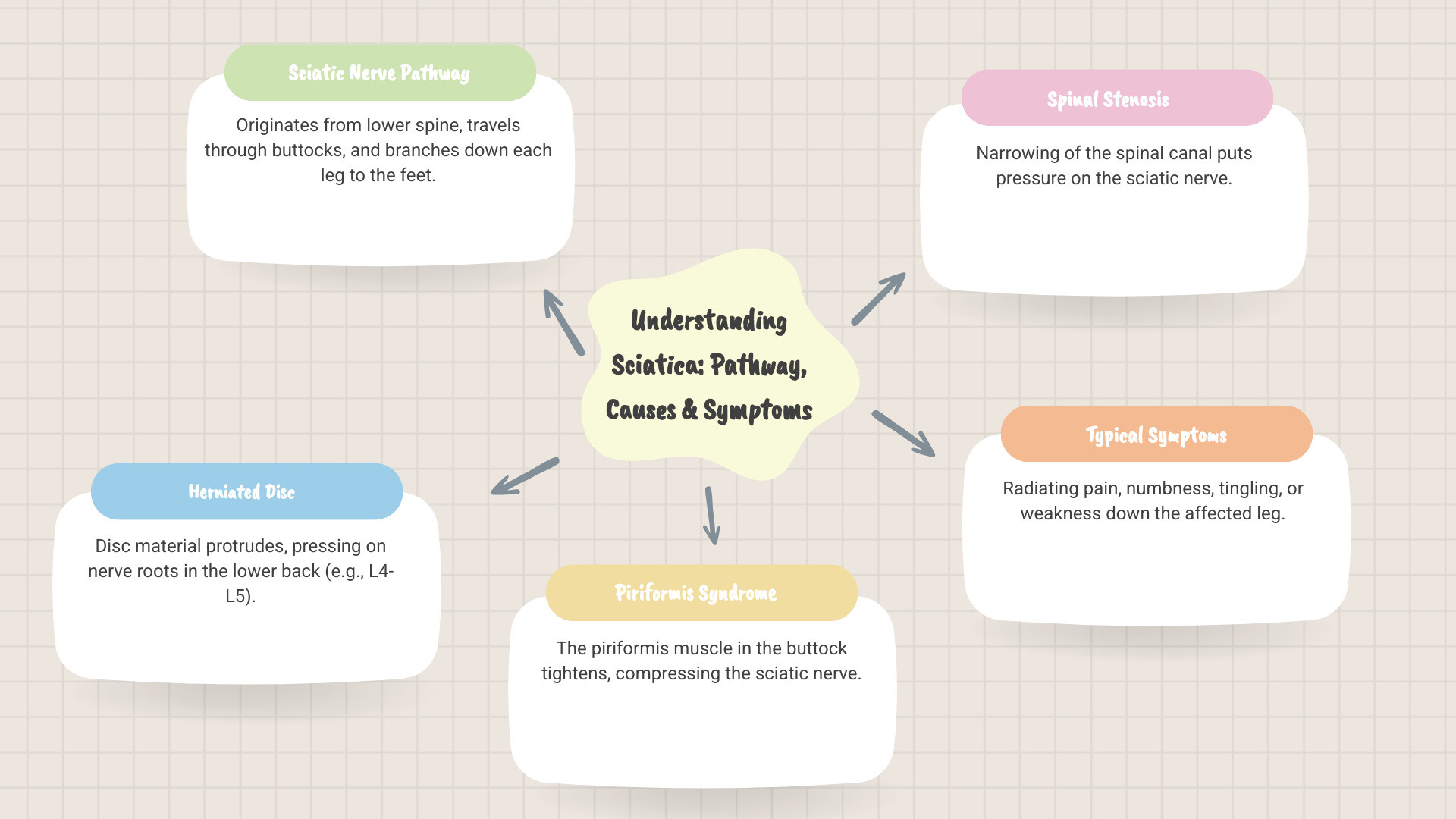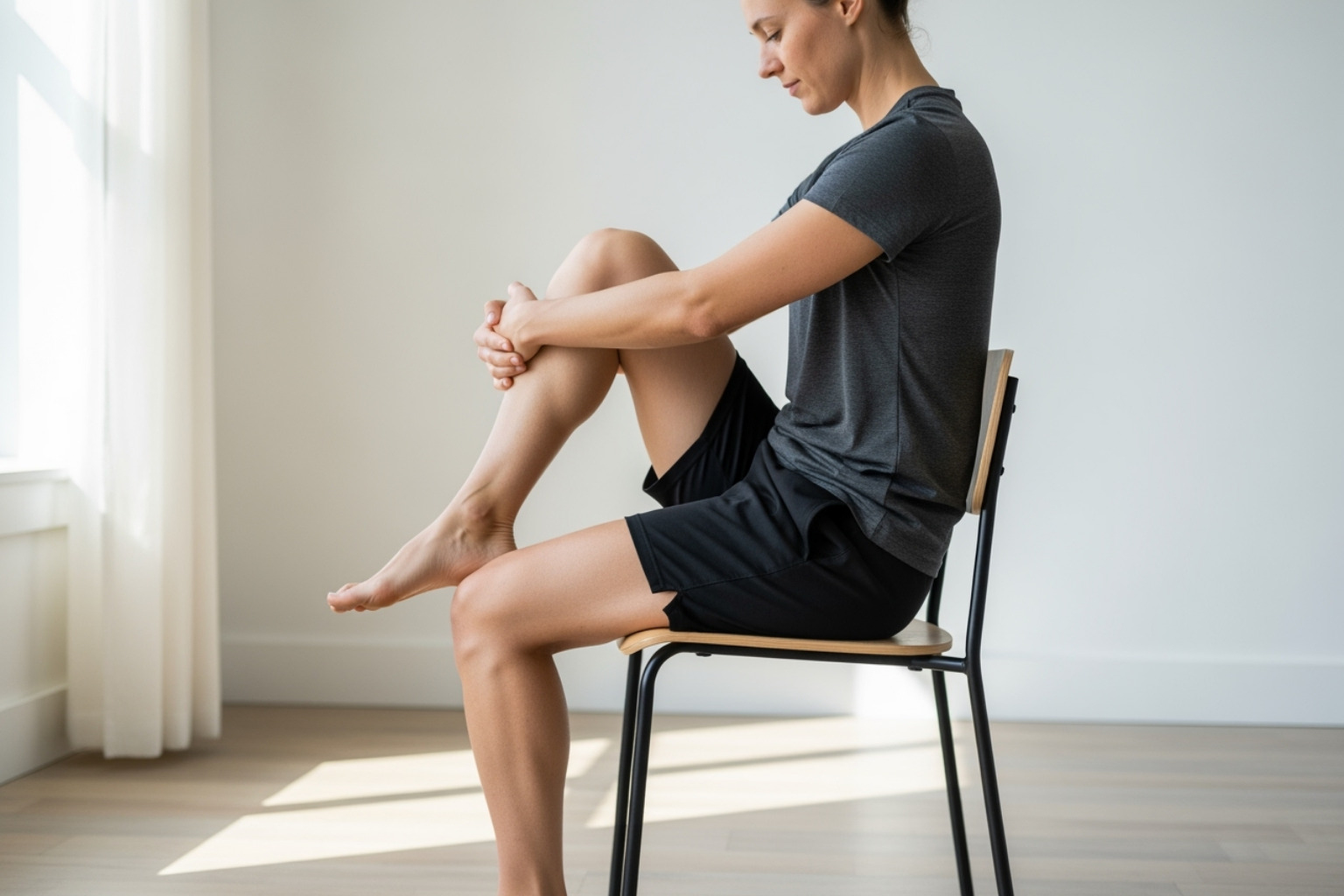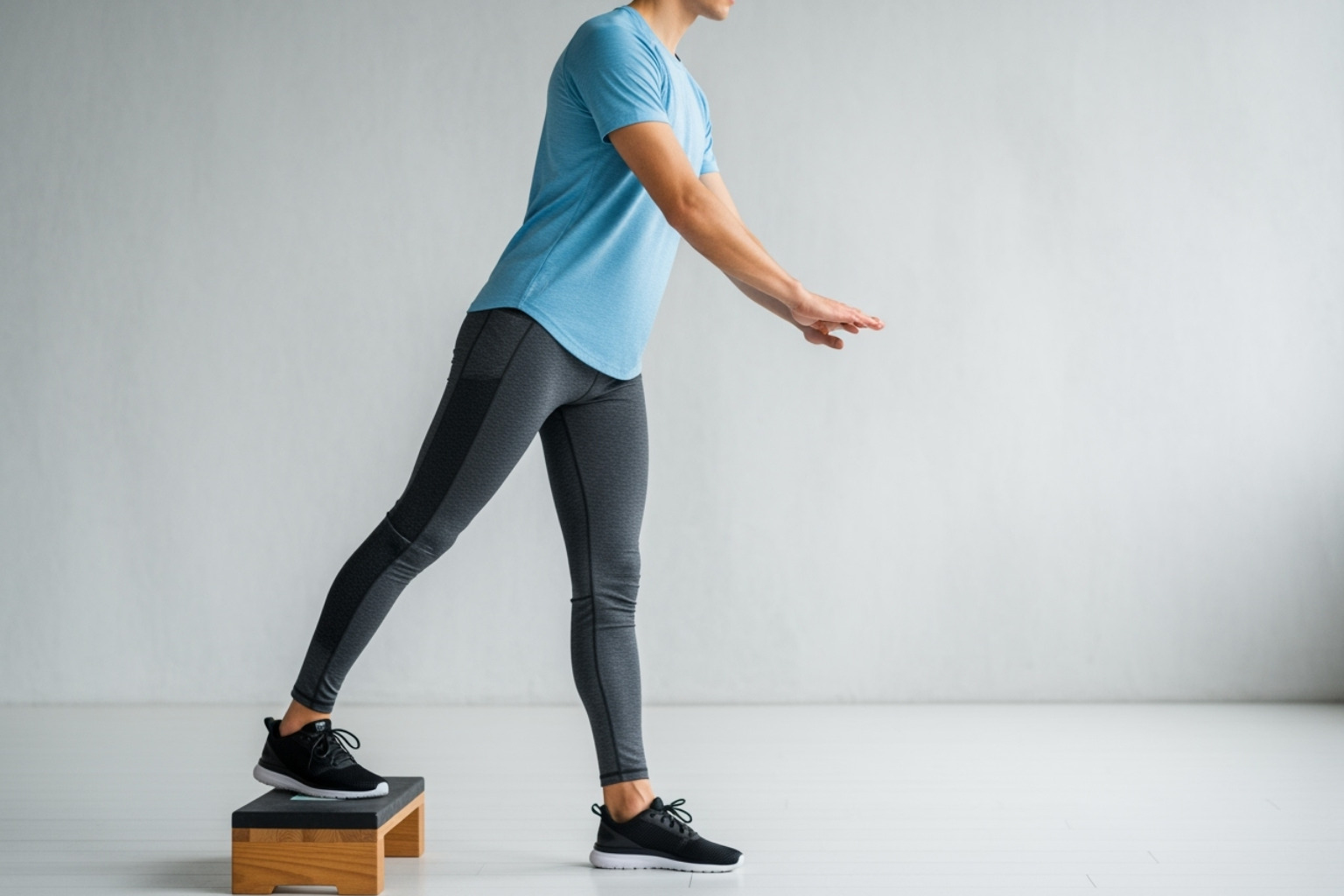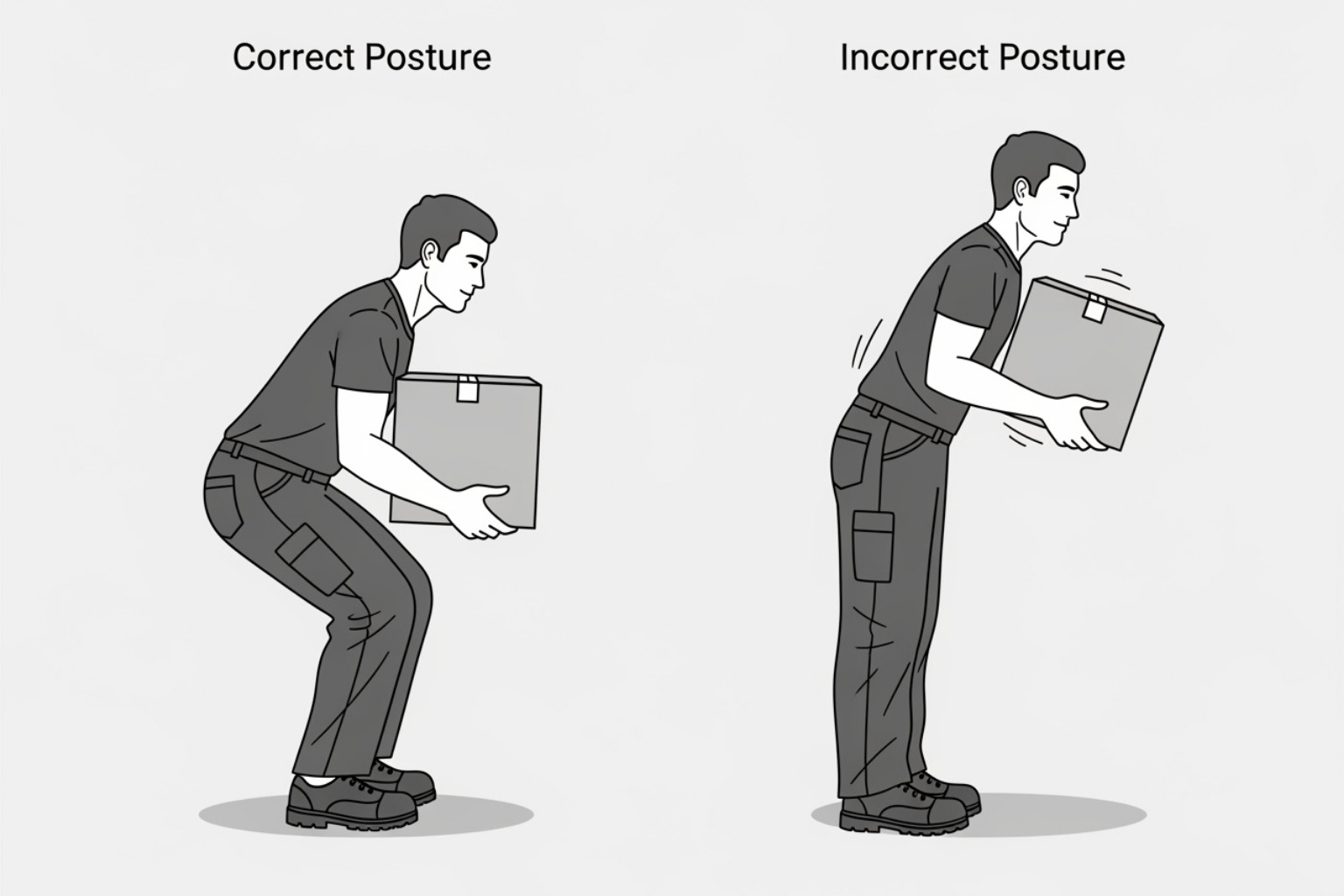Understanding Your Path to Sciatica Relief
How to relieve sciatica pain begins with understanding that relief is within reach. Sciatica occurs when the sciatic nerve, which runs from your lower back down each leg, becomes compressed. The good news? According to Harvard Health, about 90% of people with sciatica recover without surgery, often within a few weeks.
Quick Relief Methods for Sciatica Pain:
- Apply cold therapy - Use ice packs for 15-20 minutes during the first 48-72 hours to reduce inflammation.
- Switch to heat therapy - After the initial phase, apply heat to relax tight muscles.
- Keep moving gently - Short walks and gentle stretches are more helpful than bed rest.
- Try topical relief - Menthol-based creams like Neuropasil Nerve Pain Relief Cream provide targeted comfort.
- Take OTC anti-inflammatories - NSAIDs like ibuprofen can reduce pain and swelling.
- Avoid prolonged sitting - Take breaks every 30 minutes to prevent worsening symptoms.
The sciatic nerve is the longest in the body. When compressed by a herniated disc or tight muscle, it can cause pain from a dull ache to sharp, electric-shock sensations. While uncomfortable, the Cleveland Clinic notes that most cases resolve within 4-6 weeks with proper self-care.
This guide walks you through proven methods to relieve sciatica pain, from at-home strategies to professional guidance. I'm Tony Enrico, and through my work with Neuropasil, I've seen how to relieve sciatica pain effectively with natural, evidence-based approaches. Our mission is to help 1 million people find relief from aches and pains by 2028.

Understanding Sciatica: Causes, Symptoms, and When to Worry
Before learning how to relieve sciatica pain, it helps to know what's happening in your body. Sciatica isn't a condition itself; it's a symptom that something is irritating your sciatic nerve—the longest and thickest nerve in your body.
Common causes of this irritation include herniated discs, where a cushion between your vertebrae presses on the nerve. Other culprits are spinal stenosis (a narrowing of the spinal canal), piriformis syndrome (when a buttock muscle tightens around the nerve), and spondylolisthesis (a slipped vertebra). Injuries and pregnancy can also play a role. For more details, see our guide on Sciatica Symptoms.
The hallmark of sciatica is radiating pain that travels from your lower back or buttock down one leg. You might also feel numbness, tingling (a "pins and needles" sensation), or weakness in the affected leg or foot.
Differentiating Sciatica Symptoms
The pain varies, from a dull ache to a sharp, stabbing, or burning sensation, often described as an electric shock. What sets it apart is that the pain follows the nerve's path, and the leg pain is usually worse than the back pain. Activities like prolonged sitting, coughing, or sneezing can intensify the pain, which typically affects only one side.
When to Seek Medical Attention
While most cases improve with self-care, the NHS advises you to see your doctor if the pain lasts more than a few weeks, is severe and worsening, or significantly limits your daily activities.
Go to the emergency room or call 911 for red flag symptoms: sciatica in both legs, sudden and severe weakness, numbness in the genital or buttock area ("saddle anesthesia"), or loss of bladder or bowel control. These could signal cauda equina syndrome, a rare but serious condition requiring immediate medical intervention, a warning emphasized by institutions like NewYork-Presbyterian.
Immediate At-Home Sciatica Pain Relief Strategies
Encouragingly, as noted by Harvard Health, about 90% of people with sciatica recover without surgery, often within weeks.
While your first instinct may be to rest, mindful movement beats bed rest almost every time, a strategy supported by guidance from the Mayo Clinic. Staying in bed for more than a day or two can weaken muscles and prolong recovery. Instead, stay as active as your pain allows. A major trigger for sciatica is prolonged sitting, so take a movement break every 30 minutes—even just standing and stretching for a minute can help.
Using Cold and Heat Therapy Correctly
Cold and heat are powerful allies, but timing is key.
For the first 48 to 72 hours, use cold packs to reduce inflammation. Wrap an ice pack in a thin towel and apply it to the painful area for 15-20 minutes. Repeat several times a day.
After the initial phase, switch to heat therapy to relax muscles. A heating pad or warm towel applied for 15-20 minutes can improve blood flow and provide comfort. Never apply heat directly to the skin or fall asleep with a heating pad on. For ongoing pain, alternating between cold and heat can be effective. Scientific research on hydrotherapy supports the use of warmth for muscle relaxation.
Over-the-Counter Pain Relief Options
When you need extra help, over-the-counter options are available.
NSAIDs like ibuprofen (Advil) or naproxen sodium (Aleve) can reduce both pain and inflammation. Always consult a pharmacist or doctor before starting new medication, especially if you have other health conditions.
For targeted relief, topical pain relievers are highly effective. Menthol-based creams provide a cooling sensation that soothes sore muscles. Our Neuropasil Nerve Pain Relief Cream combines menthol with aloe and urea to deliver fast-acting comfort directly to the source of your pain. Applying it to your lower back and along the path of pain offers relief exactly where you need it, without systemic side effects.
How to Relieve Sciatica Pain with Stretches and Exercises
Gentle movement is one of your best allies for sciatica relief. As Harvard Health reports, 80-90% of cases improve with conservative care, with targeted stretches and exercises being a cornerstone of success. Before starting, consider getting guidance from a physical therapist to ensure you're performing movements safely. For complementary strategies, see our insights on Unlock Sciatica Relief: Quick Solutions for Lasting Comfort.
How to relieve sciatica pain with targeted stretches
These five stretches can help decompress the sciatic nerve and release muscle tension. Move gently and never force a stretch into sharp pain.
Knee-to-Chest Stretch: Lie on your back with knees bent. Gently pull one knee to your chest, hold for 30 seconds, and then slowly lower. Repeat 3-5 times on each side.

Seated Figure-4 Stretch: In a chair, cross the ankle of your affected leg over the opposite knee. Keeping your back straight, gently lean forward until you feel a stretch in your glute. Hold for 30 seconds. Repeat 3-5 times on each side.

Standing Hamstring Stretch: Place your heel on a raised surface like a step. With your leg and back straight, gently lean forward from your hips until you feel a stretch. Hold for 30 seconds. Repeat 3-5 times on each side.

Cat-Cow Pose: On your hands and knees, inhale as you drop your belly and lift your chest (Cow). Exhale as you round your spine (Cat). Flow between the two poses for 1-2 minutes.
Lying Deep Gluteal Stretch: Lie on your back with knees bent. Cross the ankle of your affected leg over the opposite knee. Grasp the thigh of the bottom leg and gently pull it toward your chest. Hold for 30 seconds. Repeat 3-5 times on each side.
How to relieve sciatica pain through low-impact activity
Low-impact activities strengthen supporting muscles and improve circulation without aggravating the nerve.
Walking: Short, gentle walks keep your spine mobile and improve blood flow. Start with 5-10 minutes and gradually increase as pain allows.
Swimming and water aerobics: The water's buoyancy reduces impact on your spine, allowing for gentle exercise. Research suggests swimming can have positive effects on nerve regeneration.
Yoga-inspired gentle movement: Gentle poses adapted to your comfort level can improve flexibility, strength, and body awareness, calming both your nervous system and the sciatic nerve.
Tai Chi-inspired gentle movement: This practice involves slow, flowing movements that promote balance and flexibility without stressing the spine.
Listen to your body with all activities. If pain increases, stop and try something gentler.
Advanced and Professional Treatments for Persistent Sciatica
If home care doesn't provide relief after several weeks, it's time to seek professional help. This is a smart move for your long-term health.
Physical therapy is often the first recommendation. A physical therapist creates a custom exercise program to strengthen your core muscles, correct your posture, and teach you how to move in ways that protect your spine. A strong core acts as a natural brace, taking pressure off the sciatic nerve.
Alternative and Complementary Approaches
Beyond conventional therapy, certain complementary approaches can help manage pain. Always discuss these with your healthcare provider.
Massage-inspired self-care can soothe muscle tension. Using a foam roller, tennis ball, or your hands to apply gentle, firm pressure to tight spots in your lower back, glutes, and hips can release tension and improve circulation. Combining self-massage with our Neuropasil Nerve Pain Relief Cream can provide an extra layer of targeted comfort.
Guided stretching and relaxation techniques like deep breathing or progressive muscle relaxation can interrupt the pain-tension cycle, giving your body a chance to heal.
Acupressure-inspired techniques involve applying pressure to specific points on the body to reduce pain. While a licensed professional can provide a full treatment, you can learn key pressure points for self-application. A meta-analysis on acupuncture for sciatica found it may help manage pain by encouraging the body to release natural pain-relieving endorphins.
Medical Interventions and When to Consider Them
When conservative treatments fail, consult a healthcare provider about medical interventions. Consult a specialist if you have severe, worsening weakness or pain that is unresponsive after several months.
Your doctor might prescribe stronger medications or suggest spinal injections of corticosteroids to reduce inflammation around the nerve. Surgery, such as a microdiscectomy or laminectomy, is a last resort for severe cases involving loss of bowel/bladder control or debilitating pain. These are significant decisions to be made with a spine specialist. For more information, medical institutions like NewYork-Presbyterian offer valuable resources.
Preventing Sciatica: Lifestyle Changes for Long-Term Health
The best way to relieve sciatica pain is to prevent it. Simple, consistent lifestyle adjustments, as recommended by sources like the Mayo Clinic, can dramatically reduce your risk and support long-term spinal health.
Maintain good posture. When sitting, use a chair with lumbar support, keep your feet flat, and position your screen at eye level. Take a break to stand and move every 30 minutes. When standing, distribute your weight evenly and keep your back straight.
Lift properly. Always lift with your legs, not your back. Bend at your knees and hips, keep the object close to your body, and move your feet to turn instead of twisting your spine.

Improve your ergonomics. Adjust your workspace and home environment to avoid awkward bending or reaching. Ensure your car seat supports your lower back.
Strengthen your core. Your core muscles support your spine. Incorporate exercises like planks, bird-dogs, and bridges into your routine a few times a week to build strength and reduce pressure on your lower back.
Maintain a healthy weight. Excess weight, especially around the midsection, strains your lower back. A balanced diet and regular activity help maintain a spine-healthy weight.
Quit smoking. Smoking reduces blood flow to your spinal discs, accelerating degeneration and increasing your risk of back problems.
Wear proper footwear. Choose comfortable, supportive shoes with good arch support to maintain proper body alignment and reduce stress on your lower back.
By adopting these habits, you build a foundation for spinal health. If you do experience discomfort, having a trusted option like Neuropasil Nerve Pain Relief Cream on hand allows you to address symptoms quickly.
Frequently Asked Questions about Relieving Sciatica Pain
When you're in pain, you want answers fast. Here are the most common questions we hear about sciatica.
How long does sciatica typically last?
The good news is that, as the Cleveland Clinic states, acute sciatica pain typically resolves within 4 to 6 weeks with self-care. An encouraging 80-90% of individuals improve without needing surgery, according to Harvard Health. If your pain persists longer than 6-12 weeks, consult a doctor to rule out more serious underlying issues and explore further treatment.
What is the fastest way to get relief from sciatica pain?
There's no single magic bullet; the fastest relief comes from a combination approach. During the first 48-72 hours, use cold therapy to reduce inflammation. Incorporate gentle movement and specific stretches to decompress the nerve. Over-the-counter anti-inflammatories like ibuprofen can reduce pain and swelling.
For immediate, targeted comfort, apply a topical cream like Neuropasil Nerve Pain Relief Cream directly to the painful area. If pain is severe and debilitating, consult a healthcare provider about medical interventions like corticosteroid injections.
What activities and positions should I avoid with sciatica?
To avoid setbacks, steer clear of certain activities during a flare-up:
- Prolonged sitting: This puts significant pressure on your lower back. Take breaks every 30 minutes.
- Strict bed rest: More than a day or two of bed rest can weaken muscles and prolong recovery. Gentle movement is better for healing.
- Heavy lifting: Avoid lifting heavy objects. If you must, use proper form: lift with your legs, not your back.
- High-impact exercise: Activities like running and jumping can jar the spine. Stick to low-impact options like walking or swimming.
- Twisting the spine: These movements can irritate the sciatic nerve. Turn with your whole body instead.
- Any movement causing sharp, shooting pain: This is your body's signal to stop. Listen to it.
Conclusion
Finding relief from sciatica pain is an achievable goal. The key to how to relieve sciatica pain is understanding that movement is your ally. Gentle stretches, short walks, and low-impact activities are often more effective than staying still.
Your path to relief will likely involve a combination of strategies. Start with cold therapy to calm inflammation, then use soothing heat to relax muscles. Support your recovery with targeted stretches and over-the-counter aids when needed. For targeted comfort that makes daily activities more manageable, topical creams like our Neuropasil Nerve Pain Relief Cream can be an essential tool.
As we've seen, most people recover from sciatica within 4-6 weeks, and 80-90% improve without surgery, according to leading medical sources. You are likely experiencing a temporary setback. By focusing on consistent self-care and preventive lifestyle changes like good posture and core strengthening, you are building a foundation for long-term spinal health.
At Neuropasil, we are committed to helping you live with less pain. When you need targeted, soothing comfort, we invite you to learn more about Neuropasil Nerve Pain Relief Cream and join the many customers who rely on it for their pain management. With each gentle stretch and mindful movement, you are moving closer to feeling like yourself again.
References
- Cleveland Clinic. Sciatica. https://my.clevelandclinic.org/health/diseases/12792-sciatica
- Harvard Health Publishing. Sciatica: Of all the nerve. https://www.health.harvard.edu/pain/sciatica-home-remedies-and-self-care
- Ji, M., et al. (2015). The Efficacy of Acupuncture for the Treatment of Sciatica: A Systematic Review and Meta-Analysis. Evidence-Based Complementary and Alternative Medicine. https://www.ncbi.nlm.nih.gov/pmc/articles/PMC4575738/
- Mayo Clinic. Sciatica. https://www.mayoclinic.org/diseases-conditions/sciatica/diagnosis-treatment/drc-20377441
- Mooventhan, A., & Nivethitha, L. (2014). Scientific Evidence-Based Effects of Hydrotherapy on Various Systems of the Body. North American Journal of Medical Sciences. https://www.ncbi.nlm.nih.gov/pmc/articles/PMC4049052/
- National Health Service (NHS). Sciatica. https://www.nhs.uk/conditions/sciatica/
- NewYork-Presbyterian. Sciatica Treatment. https://www.nyp.org/ochspine/sciatica/treatment
- Shin, M., et al. (2017). Effects of swimming exercise on nerve regeneration in a rat sciatic nerve transection model. Journal of Exercise Rehabilitation. https://www.ncbi.nlm.nih.gov/pmc/articles/PMC5439339/














